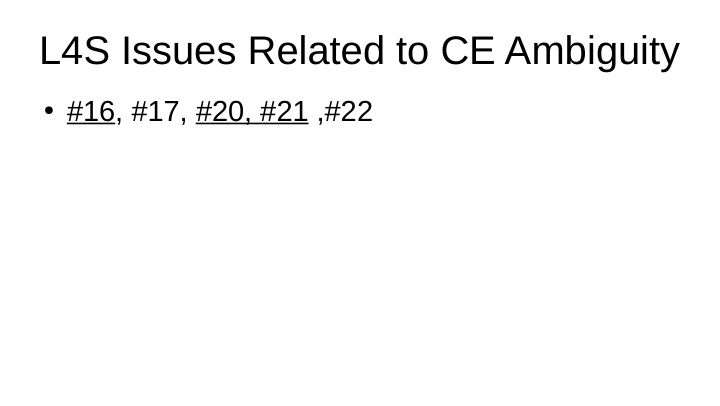



L4S Issues Related to CE Ambiguity ● #16, #17, #20, #21 ,#22
Issue #16 L4S - Interaction w/ 3168-only ECN [FIFO] AQMs ● Should still remain open, but making good progress on 3168- only AQM detection (see previous presentations) ● Prevalence moot if solution works; Solution moot if no prevalence ● Detailed solution design posted Nov'19 timeframe. Implemented and being evaluated ● Working well distinguishing DualPI2 and CoDel ● CoDel is our most stringent test, given Qdelay is lowest
Issue #21 CE codepoint semantics ● General concerns about CE ambiguity ● Two specific concerns have been raised ● #16 L4S - Interaction w/ 3168-only ECN [FIFO] AQMs ● being actively addressed ● #22 Deployment feasibility, including incremental (which is about a case where re-ordering can occur) ● been addressed ● No need for this generic placeholder issue as well?
Issue #20 Objection to ECT(1) codepoint usage ● “If ECT(1) is used for L4S ID, there should be a clear understanding of to what extent this precludes experimenting with SCE” ● The question here should not be whether the L4S precludes SCE, but whether there's anything the community might want from SCE that it can't get from L4S ● Any discussion of arrangements for parallel experiments depends on that
Issue #24 — Evaluation & testing results • Issue summary: • Questions about testing results and scenario’s • Problems with availability of code to test and reproduce results • Prague and DualPI2 code upgraded to latest kernel versions (full kernel tree available too) • [1] Shows excerpt of the test suite run on the dualQ/TCP Prague: • Per packet measurement to witness actual tail latencies instead of using coarse-grained/smoothed estimates • Scenarios mixing: • Various bottleneck bandwidth (4-200M) and base RTTs (5-100ms) • Variable number of long-running flows, with Prague/Cubic/Reno/BBR(v2) • Dynamic load — from 10 to 500 web request per sec, downloading objects from 1kb to 1MB • Unresponsive UDP flow in either queue (overload experiments) • Mixed RTTs experiments • [2] Tests reusing P. Heist’s scenarios • Proposal: • Close [1] http://bobbriscoe.net/projects/latency/dctth_journal_draft20190726.pdf [2] https://l4s.cablelabs.com/l4s-testing/README.html
- Experiment made over a bottleneck of 120Mbps - Per packet measurements during 5 mins - Mixture of two long running flows and 200 web request/s
Issue #28 — DualQ suitability • Issue summary: • Claim that “DualPI2 needs to make sure that RTT - based unfairness is removed” • Questions: • Is the goal of an AQM to police/verify RTT fairness between flows? Have these requirements also been imposed on PIE, CoDel , RED, …? • Shouldn’t the end -systems address the issues their behavior creates? • Is the end-system principle not applicable here? (Good design is to prefer end-system functionality above network functionality) • Possible AQM solutions are undesirable • provide per packet RTT information (no headers available) • Set Classic PI2 target to 1ms also (Classic underutilization and high drop probability) • Increase coupling factor to compensate worse case RTT ratio (L4S gets lower throughput in all other cases) • Proposal: • Not an issue of the AQM (additional policers will be added on if-needed basis) • Prague CC is updated with definable target RTT mapping function (code released soon) • RTT-independence solves many issues on the internet as smallest seen base RTTs and queue latencies become smaller and smaller
[1] https://www.heistp.net/downloads/sce-l4s-bakeoff/bakeoff-2019-11-11T090559-r2/sce-s1-1/batch-sce-s1-1-cubic-50Mbit-80ms_var.png
[2] https://l4s.cablelabs.com/l4s-testing/key_plots/batch-l4s-s1-1-cubic-50Mbit-80ms_var.png
Recommend
More recommend